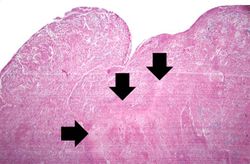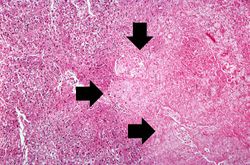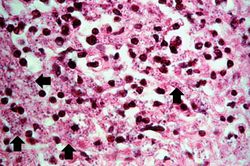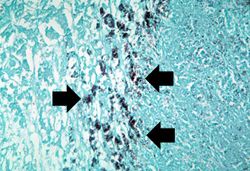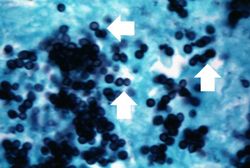Difference between revisions of "IPLab:Lab 10:Histoplasmosis"
Seung Park (talk | contribs) |
Seung Park (talk | contribs) (→Reference) |
||
| Line 33: | Line 33: | ||
== Additional Resources == | == Additional Resources == | ||
=== Reference === | === Reference === | ||
| − | + | * [http://emedicine.medscape.com/article/299054-overview eMedicine Medical Library: Histoplasmosis] | |
| + | * [http://www.merckmanuals.com/professional/infectious_diseases/fungi/histoplasmosis.html Merck Manual: Histoplasmosis] | ||
=== Journal Articles === | === Journal Articles === | ||
Revision as of 03:19, 24 August 2013
Contents
Clinical Summary[edit]
For four months before death, this two-year-old black female infant ate poorly and lost weight. When hospitalized, she appeared chronically ill with signs of infection. An exploratory laparotomy showed the patient had enormously enlarged abdominal lymph nodes, the biopsy of which disclosed active histoplasmosis. Despite intensive therapy, the patient died three weeks after admission.
Autopsy Findings[edit]
Autopsy showed widespread enlargement of lymph nodes, ulcers of the intestines, and enlarged adrenal glands exhibiting multifocal granulomas.
Images[edit]
This is an even higher-power photomicrograph of an area of necrosis (arrows). There is loss of cellular detail within this area. There are inflammatory cells present; however, it is difficult to differentiate the inflammatory cells from the native lymphocytes of the adrenal gland--which is a lymph node.
Study Questions[edit]
Additional Resources[edit]
Reference[edit]
Journal Articles[edit]
Images[edit]
Related IPLab Cases[edit]
| |||||
An infiltrate is an accumulation of cells in the lung parenchyma--this is a sign of pneumonia.

